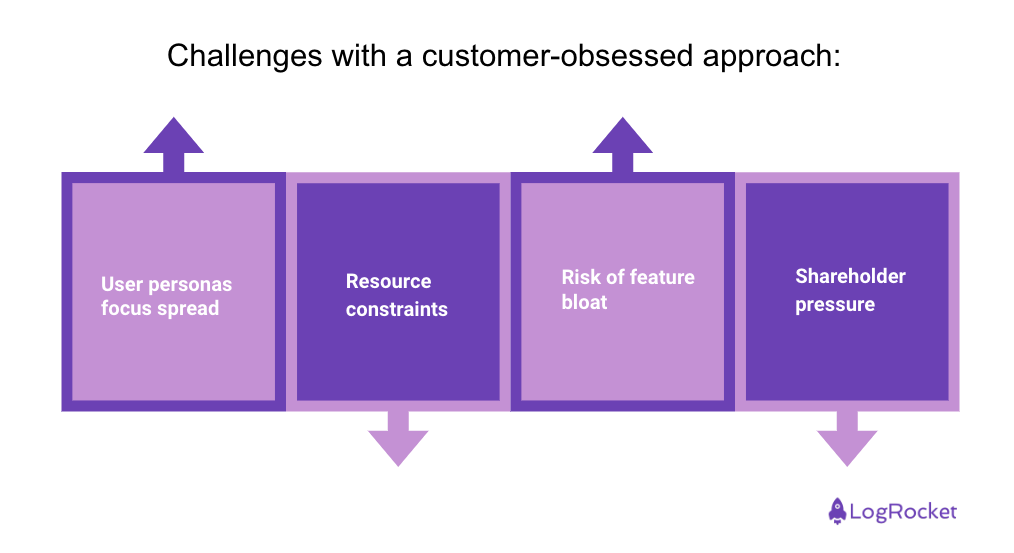When it comes to charting for product success, you can take one of two approaches. The first involves really focusing on your business by improving your bottom line, income, and long-term security. On the other hand, you could shift your attention away from solely focusing on income and put your customer at the center of your decision-making process.

In the second approach, you create a great product that users adore and then promote with excellent word of mouth. By doing so, the money follows organically and customers return again and again. This is the basic premise behind customer obsession.
Keep reading to learn more about customer obsession, as well as the steps to implement it, challenges that might arise, and common challenges that can occur.
Customer obsession is a mindset where every decision made within the company revolves around enhancing the customer experience. It’s about going beyond meeting customer needs, anticipating them, and ensuring that every interaction adds value.
Unlike a feature-based or competitor-centric approach, customer obsession puts the customer’s desires and pain points at the front and center stage, driving innovation and building loyalty.
In other words, customer obsession means immersing yourself so deeply in your customers’ world that you can deliver solutions they didn’t even know they needed. This proactive engagement transforms your customers into enthusiastic promoters of your product, fueling organic growth, and setting you apart from competitors.
However, being customer-obsessed doesn’t mean you start to ignore business metrics. It’s still important to measure them to know whether this obsession strategy works or if some other model might work better for your company and product.
At first glance, customer obsession might seem similar to customer-centricity, but there’s an important difference. While customer-centricity focuses on putting the customer at the center of decisions, customer obsession takes it a step further by being deeply engaged and proactive. It’s not just about responding to customer feedback; it’s about actively seeking it out and anticipating future needs.
As a product manager, you often need to act as the “voice of the customer” within your organizations. This means advocating for their needs in every meeting, decision, and strategy session. By building a product roadmap centered on user pain points and desired outcomes, you ensure that you’re not just adding features for the sake of it but creating meaningful solutions that resonate with our users.
Key benefits for product teams embracing customer obsession include:
In other words, in the customer obsession mode, you’re likely to have your users be fans of your product and benefit from their engagement and praise.
To create a customer-obsessed product you need to perfectly understand your users. Being caught in your bubble of negative feedback and stakeholder pressure, you may not correctly see what needs to be done and hold it to captivate your audience. In a way you have to become the users yourself without the context of knowing everything that happens in the back end of your product.
In order to do that you can take the following steps:
Regular interaction with and investing in customers’ perspectives is essential. In order to do that you’ll have to lean heavily into product discovery territory. Here are some effective methods you should consider:
Agile development is your ally here. If you have a hypothesis that a certain product change can greatly improve user experience, employ the typical A/B test and MVP routine to quickly determine whether you’re onto something. As much as this is cliche and universal, even for a more profit-driven approach, it’s still a tool that you can’t underestimate.
In order to be customer-obsessed successfully, you need to redefine your prioritization process. It’s not about the business metrics or hitting certain growth goals. You have to look at your prioritization process as if you gave the backlog to your users and they were to decide the most important things.
To help you understand how to apply customer obsession, pay attention to the following examples of real-world product organizations.
Slack has built its reputation on being exceptionally responsive to customer needs by leveraging direct lines of communication between users and product teams. It achieves this by creating shared channels where customers can interact with Slack’s developers and support staff in real time. This open dialogue allows users to report bugs, suggest new features, and share their overall experience directly with the people who can make changes. By eliminating barriers between the customer and the development team, Slack accelerates the feedback loop, enabling swift identification and resolution of pain points.
However, it’s worth noting that this might be the song of the past, as in recent times you can see there is more and more push to get clients to pay by limiting the free version more and more. Additionally, it’s worth noting that it was left behind in terms of user numbers by its competitor Microsoft Teams.
Netflix places a strong emphasis on long-term customer satisfaction by investing heavily in personalized user experiences. It utilizes sophisticated algorithms and data analytics to understand individual viewing habits, preferences, and behaviors. This data-driven approach powers everything from personalized recommendations to deciding what original content Netflix decides to produce. By tailoring the user interface and content offerings to individual tastes, Netflix ensures that each user feels like the platform was designed specifically for them, significantly enhancing user engagement and satisfaction.
I have to note that, unlike Slack, Netflix appears to still be customer-obsessed, and for good reasons. It was easy to be a successful content provider when Netflix was the only streaming platform on the planet, but things have changed since then. Despite multiple competitors emerging, Netflix remains the biggest and the most popular platform.
Adopting a customer obsession strategy comes with at least some of these difficulties:

If something is for everyone, it’s for no one. It’s easy to say to be customer-obsessed, but what do you do if your user base is really diverse and updates pleasing one group will likely be disliked by another? The key to overcoming this obstacle is to correctly identify your product’s personas and include them in the prioritization process.
Ensure you favor changes that benefit either all your users or at least most of them. While you can’t make everyone happy, it’s best to at least predict how many users can get upset with certain actions.
The truth is, that once you open the customer obsession floodgates, an unending stream of urgent changes needed by the users will open. They might be difficult to prioritize, especially when it’s hard to determine the business impact of updates strictly aimed at improving users’ quality of life (QOF).
Aiming to please every customer might not be possible due to their variety, but it can also lead to feature bloat. Adding too many functionalities, especially those that cater to specific, less common needs, can clutter your product and make it confusing. To prevent this, use the same solution as for the many personas issue. Focusing on simplicity and ease of use can enhance the overall customer experience more than an abundance of barely useful features.
Balancing customer obsession with shareholder expectations can be a delicate tightrope walk. Shareholders often prioritize short-term financial returns, pushing for strategies that quickly boost revenue but compromise product quality. Thus, this pressure can conflict with the long-term investments required for a truly customer-obsessed approach.
To beat this challenge, it’s crucial to communicate the value of customer satisfaction and loyalty to your stakeholders. Demonstrating how a happy and engaged customer base leads to sustainable growth can help align shareholder expectations with customer-centric strategies. If this doesn’t work you either say “no” to your shareholders and hope for the best or “bend the knee” in order to keep your job and ability to create a user-obsessed product in the long run.
Embracing customer obsession is critical for building products that truly resonate with users. By acting as the customer’s advocate within your development team, you ensure that every decision is made with their best interests in mind. By doing so, you not only improve user satisfaction and retention, but also create a sustainable competitive advantage. Your customers become your biggest promoters, and your product becomes indispensable in their lives.
Thank you for reading this piece. I hope it provides valuable insights for your product management career. Until the next blog post, keep putting your customers and users first!
Featured image source: IconScout

LogRocket identifies friction points in the user experience so you can make informed decisions about product and design changes that must happen to hit your goals.
With LogRocket, you can understand the scope of the issues affecting your product and prioritize the changes that need to be made. LogRocket simplifies workflows by allowing Engineering, Product, UX, and Design teams to work from the same data as you, eliminating any confusion about what needs to be done.
Get your teams on the same page — try LogRocket today.

Most teams fail at autonomy. Learn how clear rules help product teams move faster without micromanagement.

A practical framework for PMs to use AI in ideation without sacrificing judgment, strategy, or decision quality.

A practical five minute revenue estimation method to help product managers compare ideas, drop low impact features, and prioritize smarter.

A practical guide for PMs who want to stop being bottlenecks, delegate smarter, and lead teams effectively with a clear ownership framework.